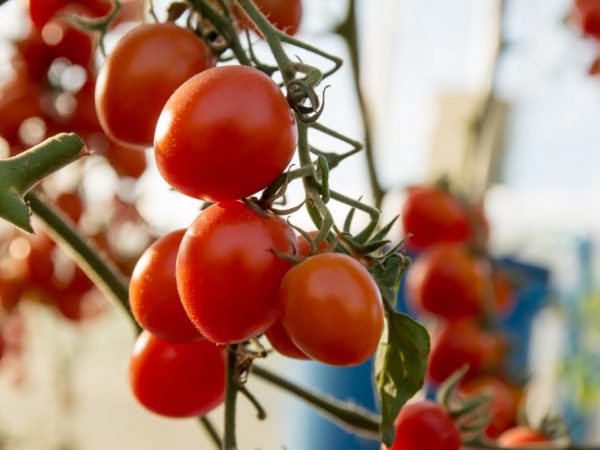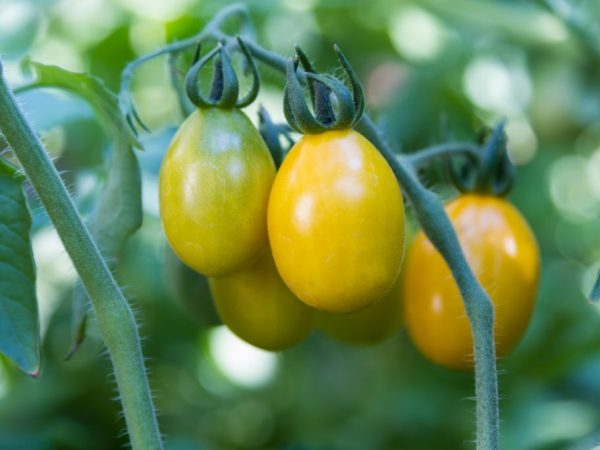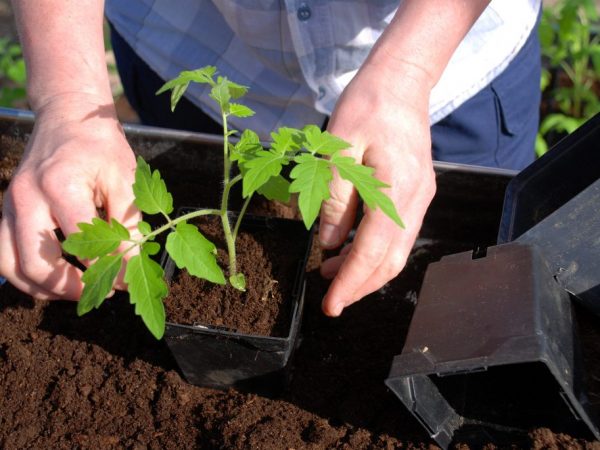Description and characteristics of De Barao tomato
Today, the owners of summer cottages and vegetable gardens often try to find high-yielding varieties of vegetables and fruits. Tomatoes are in great demand. Thanks to the many years of experience of breeders, each person can purchase any seeds or seedlings for planting in their own area. Among the many types of nightshade, the most popular is the De Barao tomato.

Description and characteristics of De Barao tomato
A distinctive feature of De Barao tomatoes is their tall growth and varietal difference. Each gardener can choose the right type of tomato for himself, according to his own preferences.
Characteristics of De Barao varieties
De Barao tomatoes are known throughout the world for their tree-like structure of bushes. Growing a plant from seeds or from seedlings, you can get a tall bush (up to 3 meters in height) with numerous side shoots. But, because of its tallness, it is very difficult for a plant to grow and develop on its own. Therefore, they are often tied to trellises.
Special attention should be paid to the description of the De Barao varieties. This tomato has a large number of fruiting branches. Fruit ripening occurs only 120 days after planting (when using seeds). De Barao's foliage is medium in size, its surface is velvety, and its color is dark green. During the flowering period, the bush looks the most beautiful. Small yellow flowers appear on its shoots, which, depending on the characteristics of the variety, are located after 3-11 leaves.
The description of the fruit also has its own characteristics. Tomatoes of these varieties are medium in size (60-90 grams), but their number on one bush may surprise an inexperienced gardener. With proper planting and care, you can get up to 10 kg of fruit from one square meter of land area. Debarau's taste also has its own differences from other varieties. The tomato pulp is very tender, sweet with a distinct sourness. These vegetables are perfect for fresh consumption, as well as for preservation. De Barao special tomatoes they have the ability to maintain their density even when used in seaming.
The color of De Barao tomatoes can vary. Depending on the variety, they can be: yellow, black, red, orange and pink.
In a photo or video, the fruits look like toy balls. In addition, each De Barao species has its own yields and growing and care requirements. Tomatoes can be planted both in open ground and in a greenhouse. The best indicators of yield and development of the crop itself are observed precisely in greenhouse conditions.
Why are De Barao tomato varieties so popular?
According to numerous reviews of gardeners, De Barao tomatoes are among the most popular on the modern market.
The fact is that the fruits themselves, if this is a variety of real De Barao tomatoes, have a delicate unforgettable taste.In addition, the cultivation of such varieties will not give even an inexperienced gardener much trouble. Those people who have already appreciated the benefits of growing De Barao tomato varieties claim that these nightshades have:
- high productivity;
- a wide range of fruit applications;
- suitability for growing in any type of soil;
- resistance to various diseases;
- "Meatiness" and juiciness of fruits;
- beautiful appearance of the bushes.
But, deciding to purchase seeds or seedlings of De Barao tomatoes, it is important to find the right variety that is suitable for growing in certain climatic conditions. The fact is that certain types of culture have their own characteristics not only for planting, but also for care. In addition, the yield and even the taste of the fruit may differ from one cultivar to another.
Varieties of De Barao varieties

The variety of varieties of varieties will appeal to any gardener
The numerous variety of De Barao tomatoes allows each person to choose the most suitable variety, not only for the taste of the fruit, but also for individual cultivation characteristics. Experts point out:
- Tomato De Barao Black. It is grown both in the greenhouse and in the open field. In addition, according to numerous reviews of gardeners, a black tomato feels great under a film in a greenhouse. Like all De Barao, this one is late maturing. The harvest will have to wait 120-130 days from sowing. A distinctive feature of this variety is the shape of the fruit. It is oblong, and their end is pointed. Plus, black tomatoes are very meaty and sweet.
- Orange. This variety has good immunity to late blight. The fruits do not crack.
- Gold. The fruit of this variety is yellow. It is oblong with a pointed end. Separate attention is paid to the yield of De Barao Golden tomato. Up to 4 kg of vegetables can be harvested from one bush.
- Red. The fruits of this variety are fleshy, sweet and sour. They are excellently devoted to storage and transportation, for which De Barao Red is so popular.
Positive reviews from dacha inhabitants and experienced breeders are associated with the large number of advantages of tomatoes. The De Barao Zolotoy variety attracted the most attention. In part, this is due to the unusual color of the fruit, as well as its size (one tomato can be up to 100 grams). In addition, like any De Barao tomato, this variety is high-yielding.
The Gigant De Barao variety is no less popular; it is almost impossible to distinguish these varieties by photo and video. This is partly due to the main advantages of the variety. It perfectly tolerates temperature changes, the fruits are heavy (up to 150 grams, and up to 7 kg of vegetables can be harvested from one bush). But, there are also disadvantages. The giant is recommended to be grown only in greenhouses.
Planting a tomato
Having decided to choose seeds as planting material, you should know about the features of growing strong De Barao seedlings. This should be done in a greenhouse or greenhouse. It is best to use a small box with fertile soil for sowing seeds. Humus is suitable for fertilization. You can also buy ready-made soil mixture. Planting the seeds itself is simple:
- It is necessary to treat the soil for planting with a weak solution of manganese.
- Plant the seeds 1 cm apart.
- Sprinkle some water over the soil.
- Cover the box with plastic and put it on the windowsill or in the greenhouse.
The sprouts should appear within a month and a half. They will be ready for landing in open ground only by 70 days. Up to this point, the sprouts should be actively watered. It is also important to remove the film from the box. Plants must get used to new conditions for themselves. It is important that this period coincides with warming. Freezing will destroy weak seedlings, so be careful. The planting itself on the land plot is carried out in small holes, 5-7 cm deep. The soil must be fertilized. 4 seedlings fit on one square meter.

It is recommended to cover young plants with a film.
Experienced gardeners advise covering the seedlings with plastic if there is a high probability of night frosts. A mini greenhouse is best. It is not difficult to make it. It is enough to install metal arcs at the landing site and attach polyethylene to them. Thus, young plants will be protected from external threats.
Features of agricultural technology of De Barao varieties
De Barao is a varietal plant. This tomato is not a hybrid. Therefore, the requirements for caring for such a vegetable are special. Agrotechnics of the De Barao tomato consists of: watering, shaping, fertilizing and seasonal removal of blooms. Since this plant is tall, we must not forget about its garter. It has its own characteristics:
- You can tie shoots both to the trellis and to the cucumber net.
- If there are no special support devices, any tree or even a fence can become it. The main thing is to plant the vegetable in the right place.
- The installation of the support should be carried out in the first days after planting the tomato, since later activities can harm the root system of the plants.
Watering also has its own characteristics. Tomatoes of these varieties have a developed root system, which provides strength to all their shoots. Therefore, De Barao needs a lot of moisture. It is best to water the bushes once every 4 days. In addition, 20-30 liters of water should be poured under each plant. It is important that the watering itself is done at the root. Water ingress on the foliage, stem or fruit can cause the tomato to become infected with various diseases. In addition, the vegetable itself can crack.
The formation of a bush, regardless of where the crop is grown (outdoors or in a greenhouse), takes place in 1 or 2 stems. All unnecessary stepsons must be removed. In addition, it is important to monitor the condition of the leaves. All dry and yellowed should be cut off. Some gardeners also recommend getting rid of the foliage on the lower shoots. Such actions will help the plant grow and develop more actively.
Fertilizing tomatoes is best when the fruit is being poured. As a top dressing, you can use a settled solution of chicken manure or mullein. It is applied together with watering at a ratio of 1:10 (if the litter is 1:20) 3 times in one season. It is best to take a break of 2 weeks between feedings.
Tips from experienced gardeners
De Barao is a variety known for its active development. New shoots, leaves, and also inflorescences constantly appear on it. In order to provide the necessary energy, the plant needs feeding. But what if the fruiting season is already coming to an end?
Experienced gardeners recommend picking off the inflorescences remaining on the bushes in August or early September. The fact is that such an operation allows you to redirect the forces of the plant to the ripening of existing fruits and not waste energy on ovaries that do not have time to become full-fledged fruits. This formation allows you to get a healthy, high-quality harvest.
Gardeners also advise not to forget about preventive spraying from diseases. Late blight is especially dangerous for De Barao. If it was not possible to protect the seedlings from the disease, the affected plant leaves should be cut off and burned. It is also important to treat tomatoes with special preparations for late blight.
De Barao varieties are among the most demanded tomatoes on the modern market. Their unusual tall qualities, as well as taste characteristics, satisfy the needs of both experienced and novice gardeners. To grow such a crop, you just need to know all the features of caring for it. Only in this way, you can get a large high-quality harvest.


